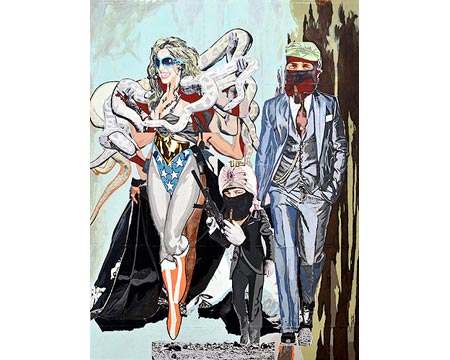
Continuing through March 27, 2010
Beneath the playful, multilayered acrylics of Claudio Dicochea's works lies a dark and disturbing secret. Inspired by 18th century Spanish casta paintings - essentially propaganda encouraging European marriage with indigenous populations appearing in the post-Conquest period in Spanish America - Dicochea incorporates both lowbrow and high art stereotypes to examine 21st century concerns regarding gender, race and class. In outlandish family portraits, he reverses the conventional white European fathers and dark-complexioned females of casta convention, with fair-skinned female media icons and swarthy, well-known father figures whose children take the form of cartoon characters or Hollywood icons (for instance, Al Pacino in 'Scarface,' Michelle Pfeiffer as Catwoman, and Calvin from 'Calvin and Hobbes'). This collision of cultural stereotypes manifests itself in Dicochea's backgrounds as well. Collage-like acrylic panels reveal a material mishmash of low-culture mediums such as graphic posters and TV color bars juxtaposed with cultural signifiers like machine guns and liquor bottles. Beginning with a printout of an actual casta painting, Dicochea brings together metaphoric imagery with layers of acid-hued acrylic paint, and then adds graphic elements as he works. Although his peculiar family portraits are, at first-glance, one-dimensional, Dicochea's works are a hybrid of Old World conventionalism and New World stereotypes that offer insight as to how relationships define our cultural identity.
